How to make a caisson for a well with your own hands: design options and methods for their implementation
Autonomous water supply in an area remote from urban infrastructure is not a luxury, but a dire necessity.Is not it? Most often, a well is used as a source of water, which requires a special arrangement - a caisson, which is required to protect the head from adverse influences and vandals.
For those who want to build a caisson for a well with their own hands, we will tell you how best to make it and where to install it. Taking into account our recommendations, any home craftsman can arrange the mouth of a water source. Here you will find out what materials and tools you will need for this.
We will consider in detail four options for constructing structures and analyze the nuances of their installation. And the videos contained in the material will clearly demonstrate the installation process of various types of caisson.
The content of the article:
What is a borehole caisson and why is it needed?
A caisson is a container that is reliably protected from water penetration. Initially they were used exclusively for underwater work, but later other areas of application were found for them.
In particular, sealed chambers began to be installed on the well head. The standard caisson has a very simple design. This is a container that closes with a hatch on top.
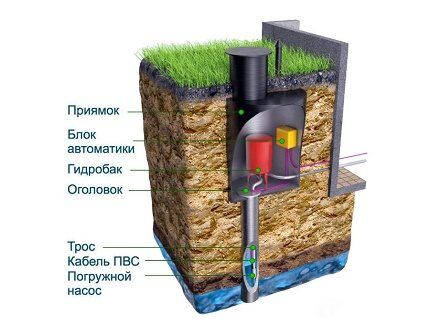
A person descends through it into the chamber to carry out maintenance and repair work.At the bottom of the device there is a casing pipe inlet, and in the side walls there are inlets for cables and water pipes.
The cover, and in some cases the walls of the caisson, are insulated. Most often, polystyrene foam or foamed polymer is used for this purpose. The chamber of classical design is made in the form of a cylinder with a height of about 2 m and a diameter of at least 1 m.
These sizes were not chosen by chance. The height of the container is determined by the need to protect the equipment installed inside it from exposure to low temperatures. The water pipe insertion area and the well head must be located below the soil freezing level.
Most often, this is a depth of the order of 1-2 m. It is this value that determines the depth of the chamber bottom and, accordingly, its height.
The diameter of the container was also not chosen by chance. It must be sufficient to install the necessary equipment and accommodate a person inside who will go down to carry out maintenance or repair of the well.
At choosing a caisson you need to understand that a structure that is too small will be inconvenient to use, and one that is too large will be too expensive. After all, sealed chambers are quite expensive equipment.
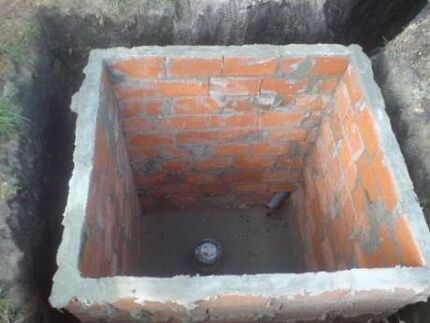
A sealed container buried in the ground performs two main functions:
- Protection of equipment from low temperatures. In winter, the water supplied from the well is exposed to negative temperatures. Under such conditions, it can freeze and damage or even rupture the pipeline.
- Protection from groundwater. The caisson prevents soil water from entering the well head, thereby extending the life of the equipment.
In addition, the caisson is a convenient place to place all the equipment necessary for operating the well.
Usually installed here pumping station, various water purification systems, well adapter, shut-off valves with electric or pneumatic drive, pipelines and automation that controls the autonomous water supply.
A waterproof chamber reliably protects all this equipment from unauthorized access and from damage by rodents and insects.

Varieties used in practice
For the manufacture of the caisson, any material can be used that provides good sealing and sufficient thermal insulation of the inner chamber.

Practice shows that most often a caisson is installed on the head from:
- Plastics. A practical solution, characterized by excellent sealing and low weight, which greatly facilitates installation and transportation. The insufficient rigidity of the structure and its tendency to float is compensated by pouring concrete into place along the contour of the chamber.
- metal, most often steel. Quite durable and very durable option. A well-made metal chamber is sealed, it does not float or deform.To prevent corrosive destruction, high-quality waterproofing is required.
- Concrete. Very strong and durable design. The large weight prevents the container from floating and significantly complicates its transportation and installation. Concrete is hygroscopic, so high-quality waterproofing of the chamber is required, otherwise moisture will penetrate inside.
- Brick. Robust, economical and durable option. It has good thermal insulation characteristics, which allows you to avoid the need for additional insulation. Installation of a brick chamber is quite complicated; it can only be carried out by a person with masonry skills.
- Polymer sand. Relatively inexpensive, sealed, strong, lightweight and very durable design. It is easy to install: it is assembled from elements connected by tongue-and-groove locks.
All of the options listed have their pros/cons. To choose the best design, you need to weigh what will be more important for you personally, for example, the high cost or speed of construction, long-term operation or efficiency of construction, etc.
Those wishing to compare practicality and technical characteristics plastic and metal caisson We suggest that you familiarize yourself with the arguments “pros and cons” of both varieties.
How to make a caisson yourself?
If desired, a home craftsman can make a caisson of any type. It is important to decide on the material from which the container will be made and its dimensions. Let's consider several options that are quite easy to implement.
Option #1 - monolithic concrete structure
For a monolithic concrete caisson, a quadrangular shape will be optimal. This will greatly facilitate the process of constructing the formwork.First, we determine the size of the pit that we have to dig for the structure.
The length of the base is usually equal to the width and is calculated as follows. To the internal size of the caisson we add the thickness of two walls equal to 10 cm and two sinuses equal to 15 cm each. We will subsequently backfill the soil into the latter.
Having decided on the width and length of the hole, we calculate its depth. It should be 0.3-0.4 m greater than the height of the chamber wall. In this way, it will be possible to arrange a drainage layer at the bottom of the pit.
This technology is chosen when it is not planned to concrete the base of the structure. If a concrete bottom is required, its height is taken into account. In addition, the depth of the pit is calculated so that the surface of the structure cover is flush with the soil level.
To determine the type of future structure, we carry out a hydrogeological assessment of the bottom of the pit. It is optimal to do this in the spring, when groundwater rises to its maximum height.
If the bottom is dry, you can get by with a drainage layer. If the bottom of the pit is wet, it makes sense to equip a completely sealed bottom of the structure. Otherwise, groundwater may flood the caisson.
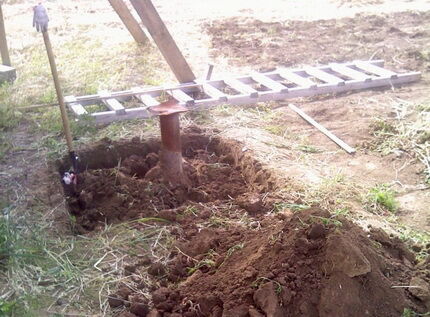
When marking the future pit, pay attention to the fact that it is better to place the camera asymmetrically in relation to the casing pipe. This way there will be more free space inside the container for the person who descends into it to work.
In addition, in this case the equipment can be positioned with greater convenience. Having decided on the size and location of the pit, we begin the excavation work.
During their implementation, you can immediately dig a trench for water pipes to the house. After the hole is ready, we begin arranging the drainage.
It will consist of two layers:
- A sand cushion about 10 cm high. Pour the sand and compact it thoroughly.
- Crushed stone about 15 cm high.
Such drainage will not allow water that gets into the caisson to remain inside. It will quickly go into the ground. Next, we proceed to arranging the formwork. There are two options for its installation.
The first involves using the walls of the pit as the outer walls of the formwork. We cover the sides of the pit with thick polyethylene so that water from the concrete does not go into the ground. After this, we proceed to arranging the frame from reinforcement.

For it, you can take a steel coarse-mesh plaster mesh or tie it yourself in increments of 30 cm. We fasten the reinforcement so that it is inside the future concrete layer, after which we install the second wall of the formwork.
For it, you can take boards or wood-polymer boards. The second option for arranging the formwork involves the use of boards knocked down from boards.
They are installed in the pit so that they form double walls. The reinforcement is installed between them and the structure is ready for pouring.This method will require the use of more boards, but it makes it possible to arrange drainage sinuses, which is impossible in the first option.
Drainage sinuses are necessary when groundwater is high, otherwise the caisson will flood.
Let's start pouring concrete. Mixing the solution by hand is a very labor-intensive process. It is much easier to rent a concrete mixer or make one yourself from a metal barrel of a suitable size.
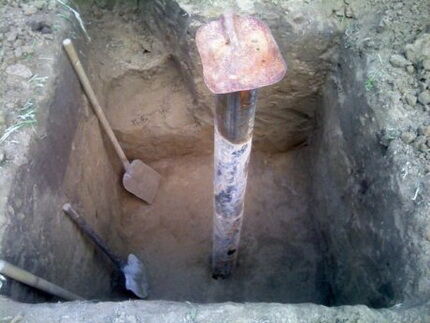
To supply the solution into the formwork, you need to make a special tray; a vertically cut used drain pipe will also work. We pour the concrete in small layers, each of which must be thoroughly compacted.
For compaction we need an electric vibrator. This is a special tool that is quite expensive. If possible, it would be good to rent one. If not, you will have to use another sealing method - bayoneting.
To implement this, you must first make a special device. We take a thin pipe, a pin or a piece of fittings and weld handles to it.
The resulting tool is sharply immersed in freshly poured concrete. Then we begin to remove it, we do it slowly, rocking the device from side to side. During the bayonet process, air and water rise to the surface, and the concrete becomes denser.
After the entire structure has been filled, it needs to be dried properly. During the first 3-5 days, the concrete has not yet set and needs to be maintained with moisture.
The fact is that during the solidification process, active evaporation of water continues in its upper layers. If there is not enough moisture, the upper layers of the concrete structure begin to crack, which leads to a decrease in the strength of the entire chamber.
Therefore, after pouring, the concrete is regularly sprayed with water or, in case of heat, covered with a damp cloth. After a week, the formwork can be removed.
However, concrete will gain full strength only after 28 days. It is then that you can begin finishing work. The easiest way would be to install a factory-made floor slab equipped with a hatch.
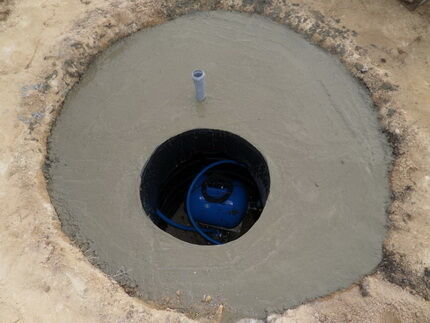
Another option is to fill the floor by first performing horizontal formwork. All work on installing formwork and pouring concrete mortar is carried out similarly to those already carried out. After the structure has completely dried, do not forget to carry out waterproofing work.
The following photo selection will present the process of pouring a concrete caisson step by step:
Option #2 - caisson made of concrete rings
Construction of a borehole caisson made of concrete and reinforced concrete rings begins with preparing the pit. Its depth is calculated similarly to a monolithic structure. The height of the bottom of the structure depends on its type.
It can also be sealed or represent a drainage layer. The choice of type is made taking into account the level of groundwater.
Consider the option with a sealed bottom. We dig a pit of the required depth, level the bottom and lay a sand cushion about 10 cm high on it. We compact it well.

Preparing the concrete bottom for installation. We drill a hole in the slab for borehole pipe. Then, using special equipment, we carefully lower the bottom down, passing the casing into the prepared hole. We place the slab on a sand cushion.
We begin preparing for the installation of concrete rings. We carefully coat each of them with a waterproofing compound, for example, bitumen mastic and let it dry.
We lower the rings into the pit, carefully treating each joint with a fastening compound. Some experts advise foaming the seams, explaining that the mortar will collapse when the earth moves, but the more plastic foam should remain unharmed.
We treat the resulting seams with waterproofing. We lay a ceiling with a hatch on top.

The caisson is ready. All that remains is to fill in the voids around the structure.
Option #3 - budget brick camera
Its arrangement resembles the construction of a monolithic caisson made of concrete. We start by digging a pit. It can be dug exactly for the future container or made a little larger.
The second option is preferable. It involves filling all voids into which rainwater can flow after the walls of the chamber are erected and dry.
In the first case, the brick will be laid against the wall of the pit, but no one can guarantee that there are no voids behind it.
Regardless of whether the bottom of the caisson is sealed or not, a strip foundation is made for the brick chamber, the width of which should be slightly larger than the thickness of the future masonry. We dig a trench about half a meter deep along the perimeter of the structure, fill it with a layer of sand 10-15 cm high and compact it well.
The future foundation does not have to be concrete. As an option, you can fill the trench with brick fragments, large crushed stone and fill it with sand-cement mortar.
After the backfill has set, you can begin laying. We lay waterproofing on the foundation; it can be either roofing felt or any other suitable material.
We start laying from the corner, filling the seams well with mortar. From time to time we check the quality of work using a plumb line and level. When the height of the masonry reaches the cable entry level and external water supply branch, between the bricks we insert sleeves under the entrances.
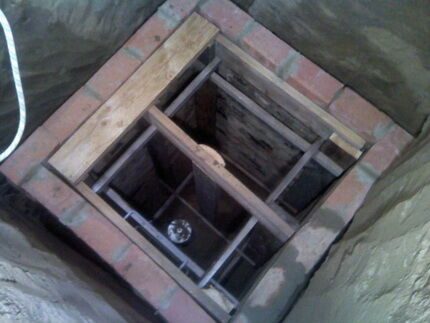
We bring the masonry to the desired height. Let it dry, then plaster it or treat it with a special solution for waterproofing.
Let's start arranging the bottom of the container. If it must be airtight, install an armored belt at a height of 4-5 cm from the bottom level. Then we pour the concrete. Its height should be about 15 cm. If the bottom should not be sealed, lay a layer of crushed stone and compact it well.
The covering of a brick caisson can be different. You can lay a finished slab or do it yourself.In the second case, we place sections of channels, beams or boards on the upper walls of the chamber.
We fix the ventilation duct, the hatch and the sleeve for the irrigation pipe at the required level. Then we cover the resulting structure with tin or plastic film if the sheathing is laid without gaps.
To strengthen the structure, we place a reinforcing mesh at a height of 4-5 cm from its base. Pour the concrete and wait for it to dry. After this, we arrange the neck of the chamber. Then we fill the container to the soil level and install the hatch.
If there is a desire to reduce the cost of the structure, the top floor does not need to be filled with concrete. It can be covered with soil, creating a hill 0.3-0.4 m high.
Option #4 - sealed metal container
A metal caisson can be of any shape; it is most often determined by the available material. For a quadrangular chamber you will need 3-5 mm rolled metal and a rod or reinforcement with a cross-section of 10 mm.
A round container can be constructed from sections of industrial pipe with a diameter of 1250 mm for the body and about 600 mm for the neck.
When choosing the shape of the future container, we take into account that the fewer welds there are, the less chance of their destruction and, accordingly, loss of chamber sealing.

We begin work by calculating the preparation of the pit. We dig a hole of the required size and level its bottom.
We cut the casing pipe at a height of 40-50 cm from the bottom and temporarily cover it with plastic or rags. We clean the prepared metal parts from rust and place them on a boardwalk, which will prevent them from becoming dirty during work. We start by making the bottom.
We prepare a part of the desired shape and cut out a hole in it into which the casing sleeve will be inserted. For its installation we use double-sided welding.
If we are making a quadrangular chamber, we cut out the side walls from rolled metal. We mark them and cut out holes for cable and pipeline entries. We connect the bottom and side walls.
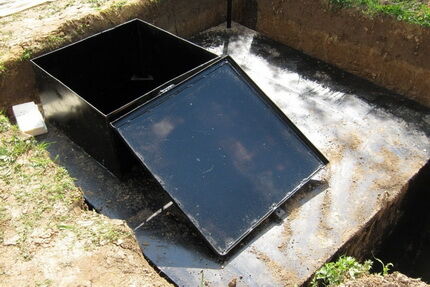
Replace the lid of the container. Do not forget that all welding seams must be made only on both sides. This will ensure the necessary tightness of the caisson.
We weld the neck and the pencil case under the ventilation. We weld sleeves for the cable and pipeline to the walls of the chamber. We fasten the loops from the rod or reinforcement that will be needed to secure the slings. Attach the hatch or cover.
Let's start waterproofing work.All welding seams, both external and internal, are thoroughly cleaned of slag.
After this, we treat them several times with a protective composition. We do the same with the entire structure. As a result, we should have a multi-layer external bitumen waterproofing. Inside we apply primer, paint and anti-corrosion compound.
If necessary, we insulate the camera. To do this, you can use extruded polystyrene foam or other insulation. It is important that it is not hygroscopic.
The metal caisson is ready, it can be lowered into the pit. To install the structure, a crane equipped with soft slings is used. We install wooden blocks above the pit, on which we place the container.
Then we remove the supports, and very carefully and slowly lower the structure down, placing it on the casing. The caisson that has risen to the bottom of the pit must be leveled.
We insert pipes and cables into the sleeves. We check the waterproofing. We re-process the areas where it was damaged during installation.

We weld the sleeve to the casing or foam it if the casing is made of plastic. We carry out work to seal the areas where power cables and pipelines enter. After which you can fill in the caisson.
If you do not want to build an underground chamber for placing equipment in a small summer cottage, we recommend that you familiarize yourself with the option well construction without a caisson. If you use a water source seasonally, this is an excellent option.
Conclusions and useful video on the topic
Video #1. How to install a metal caisson:
Video #2. The manufacturing process of a monolithic concrete caisson:
Video #3. How to arrange a brick caisson:
There are many ways to make a caisson for a well yourself. Which one to choose depends on the characteristics of the site, the qualifications of the home craftsman and his financial capabilities.
In any case, if all the work is carried out correctly and efficiently, the resulting sealed chamber will reliably protect the well head from freezing and the ingress of surface melt and flood waters. This guarantees an uninterrupted supply of clean water to the house.
Tell us about your own experience in arranging a caisson for a well in a suburban area. Please write in the block below. Here you can comment on the information we provide and ask questions.




Which budget caisson to choose in Siberian conditions with ground freezing by 2.5-3 meters in winter? Brick?
Hello, Vitaly. Brick is a very good solution for implementing a budget caisson for a well. Just use red brick, which is not afraid of moisture, unlike white.
In the north of eastern and western Siberia, the depth of soil freezing can indeed reach three or more meters, but this will not in any way affect the equipment that will be located in a brick caisson.
I would like to note right away that if you have groundwater, you will have to make a concrete foundation and waterproof the caisson.
The implementation of a brick caisson is not so difficult; the most difficult thing will be to dig a pit. As an example, I will give a photo of a personal implementation. The lower part of the caisson was 1.4 x 1.4 m, 2 m high. Next, the upper concrete floor with a hatch was poured, reinforced with 8 mm reinforcement, the thickness of the cover was 15 cm.
There is a metal cap on top, since the brick is finished. In winter, there is a bottle of water in the caisson for control, which has never frozen in 2 years.